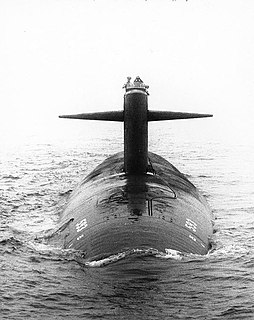This page is based on this
Wikipedia article Text is available under the
CC BY-SA 4.0 license; additional terms may apply.
Images, videos and audio are available under their respective licenses.

USS Glenard P. Lipscomb (SSN-685) was a nuclear-powered attack submarine of the United States Navy.

The Mare Island Naval Shipyard (MINSY) was the first United States Navy base established on the Pacific Ocean. It is located 25 miles northeast of San Francisco in Vallejo, California. The Napa River goes through the Mare Island Strait and separates the peninsula shipyard from the main portion of the city of Vallejo. MINSY made a name for itself as the premier US West Coast submarine port as well as serving as the controlling force in San Francisco Bay Area shipbuilding efforts during World War II. The base closed in 1996 and has gone through several redevelopment phases. It was registered as a California Historical Landmark in 1960, and parts of it were declared a National Historic Landmark District in 1975.

An attack submarine or hunter-killer submarine is a submarine specifically designed for the purpose of attacking and sinking other submarines, surface combatants and merchant vessels. In the Soviet and Russian navies they were and are called "multi-purpose submarines". They are also used to protect friendly surface combatants and missile submarines. Some attack subs are also armed with cruise missiles mounted in vertical launch tubes, increasing the scope of their potential missions to include land targets.
The S1C reactor was a prototype naval reactor designed for the United States Navy to provide electricity generation and propulsion on warships. The S1C designation stands for:

The Permit-class submarine,, was a class of nuclear-powered fast attack submarines in service with the United States Navy from the early 1960s until 1996. They were a significant improvement on the Skipjack class, with greatly improved sonar, diving depth, and silencing. They were the forerunners of all subsequent US Navy SSN designs. They served from the 1960s all the way through to the early 1990s, where they were decommissioned due to age. They were followed by the Sturgeon and Los Angeles classes.

The Skipjack class was a class of United States Navy nuclear submarines (SSNs) that entered service in 1959-61. This class was named after its lead boat, USS Skipjack. The new class introduced the teardrop hull and the S5W reactor to U.S. nuclear submarines. The Skipjacks were the fastest U.S. nuclear submarines until the Los Angeles-class submarines, the first of which entered service in 1974.
A nuclear submarine is a submarine powered by a nuclear reactor. The performance advantages of nuclear submarines over "conventional" submarines are considerable. Nuclear propulsion, being completely independent of air, frees the submarine from the need to surface frequently, as is necessary for conventional submarines. The large amount of power generated by a nuclear reactor allows nuclear submarines to operate at high speed for long periods of time; and the long interval between refuelings grants a range virtually unlimited, making the only limits on voyage times being imposed by such factors as the need to restock food or other consumables.

USS Simon Lake (AS-33) was the lead ship of her class of submarine tenders in the United States Navy, named for Simon Lake, a pioneering designer of early submarines.

The United States' S-class submarines, often simply called S-boats, were the first class of submarines with a significant number built to United States Navy designs. Others of this class were built to contractor designs.

An SSN is a nuclear-powered general-purpose attack submarine. SSN is the US Navy hull classification symbol for such vessels; the SS denotes a submarine and the N denotes nuclear power. The designation SSN is used for interoperability throughout NATO under STANAG 1166. though navies use other terms.
The Lake Torpedo Boat Company of Bridgeport, Connecticut was an early builder of submarines for the United States Navy in the early 20th Century.

Turbo-electric transmission uses electric generators to convert the mechanical energy of a turbine into electric energy and electric motors to convert it back into mechanical energy to power the driveshafts.
The S2C reactor is a naval reactor used by the United States Navy to provide electricity generation and propulsion on warships. The S2C designation stands for:

Passive Underwater Fire Control Feasibility System (PUFFS) was a passive sonar system for submarines. It was designated AN/BQG-4 and was primarily equipped on United States Navy conventional submarines built in the 1950s beginning with the Tang class, and also those converted to GUPPY III or otherwise modernized in the 1960s. It was also equipped on the nuclear-powered USS Tullibee (SSN-597). A version known as "Micropuffs" was fitted on Oberon-class submarines for the Royal Australian Navy, and as Type 2041 on the Upholder-class for the British Royal Navy. This class still serves in the Royal Canadian Navy as the Victoria class, where Micropuffs is known as BQG-501. The system was notable for three tall, fin-like domes topside, except on Micropuffs installations. The system was retained on several submarines transferred by the US to foreign navies. It was associated with long-range passive detection of targets for the Mark 45 nuclear torpedo and other weapons. Most submarines backfitted with it were also lengthened 12-16 feet to accommodate additional electronics and plotting rooms. It was also planned for Thresher and Sturgeon class nuclear submarines, but was not fitted on them except Micropuffs experimentally on Barb and Haddock. With the exception of the four Canadian Victoria-class submarines, all PUFFS-equipped submarines have been disposed of or preserved as museum ships.

Tulliby Lake is a hamlet in central Alberta, Canada within the County of Vermilion River. It is located approximately 23 kilometres (14 mi) north of Highway 45 and 50 kilometres (31 mi) northwest of Lloydminster.
Tulaby Lake is a lake in Becker and Mahnomen counties, in the U.S. state of Minnesota.













